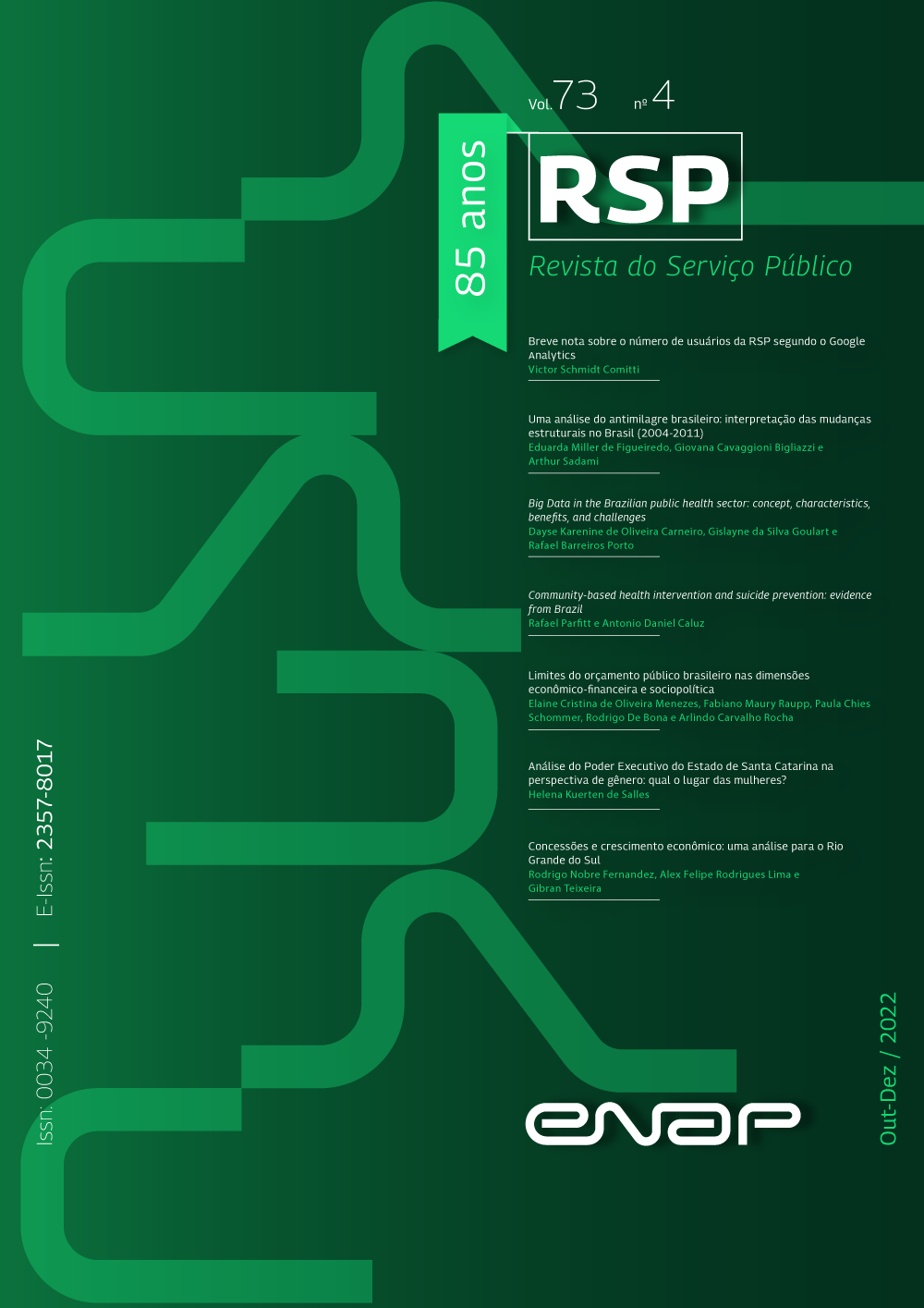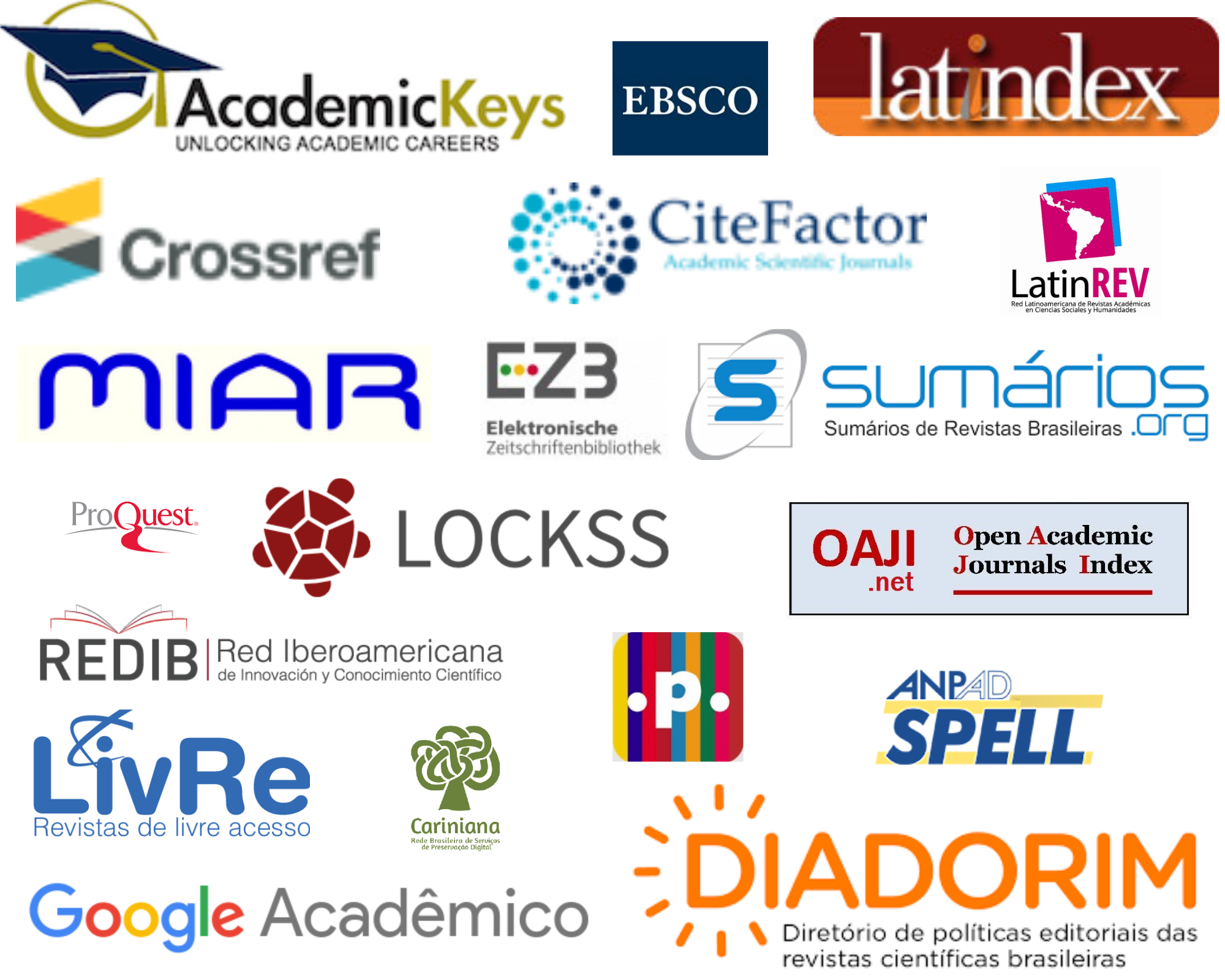Big Data in the Brazilian public health sector
concept, characteristics, benefits, and challenges
Keywords:
Big Data, setor público de saúde, governo eletrônico, BrasilAbstract
Big Data (BD) has arisen as a strategic way to manage and process varied and elevated volume of information that is published these days. In this context, the purpose of this article is to investigate the adoption of Big Data (BD) for the management of financial resources related to Brazilian public health services and activities, in the perception of the actors involved. Using the multimethod approach, we propose a concept of BD in the public health sector; characterize the adoption of BD in an organization within this sector with attributes such as volume, velocity, variety, value, veracity, variability and visualization; and finally, identify categories and variables in the literature which are related to the challenges and benefits that are present and absent in this phenomenon, as well as new variables related to managerial benefits: sustainability and leadership support. The results offer an opportunity to understand the use of BD in the Brazilian public health sector, especially for the efficient management of the resources used to create collective value in public health.
Downloads
References
Abu-Shanab, E. A. (2020). E-government contribution to better performance by public sector. In:
Open Government: Concepts, Methodologies, Tools, and Applications. IGI Global, 2020. p. 1-17. DOI:
4018/978-1-5225-9860-2.ch001
Akhavan-Hejazi, H.; Mohsenian-Rad, H. (2018). Power systems big data analytics: An assessment of
paradigm shift barriers and prospects. Energy Reports, v. 4, p. 91-100. DOI: https://doi.org/10.1016/j.
egyr.2017.11.002
Archenaa, J.; Anita, E. M. (2015). A survey of Big Data analytics in healthcare and government.
Procedia Computer Science, v. 50, p. 408-413. DOI: https://doi.org/10.1016/j.procs.2015.04.02 1https://
doi.org/10.1016/j.procs.2015.04.021
Arnold-Schmitt, L. E.; Triska, R. (2014). Informação na área da saúde em tempos de comunicação
móvel, Big Data e computação cognitiva. Razón y palabra, v. 18, n. 88.
Bardin, L. (2011). Análise de conteúdo. 3 reimp. Lisboa: Edições, 70.
Blazquez, D.; Domench, J. (2018). Big Data sources and methods for social and economic analyses.
Technological Forecasting and Social Change, v. 130, p. 99-113. DOI: https://doi.org/10.1016/j.
techfore.2017.07.027.
Brasil. (1988). Constituição da República Federativa do Brasil. Brasil. Disponível em:
planalto.gov.br/ccivil_03/Constituicao/Constituicao.htm>. Acesso em: 8 abr. 2021.
Brasil. (2018). Lei nº 13.709, de 14 de agosto de 2018. Lei Geral de Proteção de Dados. Disponível em:
<>. Acesso em: 11 abr. 2021.
Bryman, A. (2003). Quantity and quality in social research. Routledge.
Chandra, Y.; Shang, L. (2017). An RQDA-based constructivist methodology for qualitative research.
Qualitative Market Research, v. 20. n. 1, p. 90-112. DOI: https://doi.org/10.1108/QMR-02-2016-0014
Chen, C. L. P.; Zhang, C. Y. (2014). Data-intensive applications, challenges, techniques, and technologies:
A survey on Big Data. Information Sciences, v. 275, p. 314-347. DOI: 10.1016/j.ins.2014.01.015
Chen, M.; Mao, S.; Liu, Y. (2014). Big Data: A Survey. Mobile Networks and Applications, v. 19, n. 2, p.
–209. DOI: 10.1007/s11036-013-0489-0
Criado, J. I.; Gil-Garcia, J. R. (2019). Creating public value through smart technologies and strategies.
International Journal of Public Sector Management. DOI: https://doi.org/10.1108/IJPSM-07-2019-0178
Dash, S. et al. (2019). Big data in healthcare: management, analysis and future prospects. Journal of Big
Data, v. 6, n. 54. DOI: https://doi.org/10.1186/s40537-019-0217-0
De Vries, H.; Bekkers, V.; Tummers, L. (2016). Innovation in the public sector: A systematic review
and future research agenda. Public administration, v. 94, n. 1, p. 146-166. DOI: https://doi.org/10.1111/
padm.12209
Dias, G. P. (2019). Fifteen years of e-government research in Ibero-America: A bibliometric
analysis. Government Information Quarterly, v. 36, n. 3, p. 400-411. DOI: https://doi.org/10.1016/j.
giq.2019.05.008
Fredriksson, C. (2017). et al. Big data in the public sector: A systematic literature review. Scandinavian
Journal of Public Administration, v. 21, n. 3, p. 39-62.
Fundo Nacional de Saúde. (s.d.). Arquivos de Repasse Anual Fundo a Fundo: Repasse FAF com
População – 2002 a 2018. Disponível em: < https://portalfns.saude.gov.br/publicacoes/. Acesso em: 11
abr. 2019.
Giacalone, M.; Cusatelli, C.; Santarcangelo, V. (2018). Big Data Compliance for Innovative
Clinical Models. Big Data Research. DOI: https://doi.org/10.1016/j.BDr.2018.02.001
Gil-Garcia, J. R.; Flores-Zúñiga, M. Á. (2020). Towards a comprehensive understanding of digital
government success: Integrating implementation and adoption factors. Government Information
Quarterly, v. 37, n. 4, p. 101518. DOI: https://doi.org/10.1016/j.giq.2020.101518
Goulart, G. da S.; Viana, M. M. & Lucchese-Cheung, T. (2021). Consumer perception towards
familiar and innovative foods: the case of a Brazilian product. British Food Journal, v. 123, n. 1, p. 125-
DOI: https://doi.org/10.1108/BFJ-02-2020-0160
Günther, W. A. et al. (2017). Debating Big Data: a literature review on realizing value from Big
Data. Journal of Strategic Information Systems, v. 26, p. 191–209. DOI: http://dx.doi.org/10.1016/j.
jsis.2017.07.003
Hashem, I. A. T. et al. (2015). The rise of “Big Data” on cloud computing: review and open research
issues. Inf. Syst., v. 47, p. 98-115. DOI: https://doi.org/10.1016/j.is.2014.07.006
Hadi, M. S. et al. (2018). Big Data analytics for wireless and wired network design: A survey. Computer
Networks, v. 132, p. 180-199. DOI: https://doi.org/10.1016/j.comnet.2018.01.016
IQBAL, M. et al. (2018). A study of big data for business growth in SMEs: Opportunities & challenges. In:
International Conference on Computing, Mathematics and Engineering Technologies (iCoMET).
IEEE. p. 1-7. DOI: 10.1109/ICOMET.2018.8346368.
Janssen, M. & Van Den Hoven, J. (2015). Big and Open Linked Data (BOLD) in government: A
challenge to transparency and privacy?. DOI: https://doi.org/10.1016/j.giq.2015.11.007
Justo, a.m., & camargo, b.v. (2014). Estudos qualitativos e o uso de softwares para análises lexicais. In
Caderno de artigos: X SIAT & II Serpro (p. 37–54). UNIGRANRIO.DOI: <https://lageres.wordpress.
com/>
Kim, G-H, Trimi, S. & Chung, J-H. (2014). Big-Data Applications in the Government Sector.
Communications of the ACM, v. 57, n. 3, p. 78-85. DOI: 10.1145/2500873
Kulkarni, A. J. et al. (Ed.). (2020). Big Data Analytics in Healthcare. Springer, Cham. DOI: https://doi.
org/10.1007/978-3-030-31672-3
Kumar, Y. et al. (2020). Big Data analytics and its benefits in healthcare. In KULKARNI, A. J. et al. Big
Data Analytics in Healthcare. Springer, Cham, p. 3-21. DOI: https://doi.org/10.1007/978-3-030-31672-
_1
Löfgren, Karl, Webster, C. William R. (2020). The value of Big Data in government: The case of
‘smart cities’. Big Data & Society, v. 7, n. 1, p. 2053951720912775.
Marchand, P.& Ratinaud, P. (2012). L'analyse de similitude appliqueé aux corpus textueles: les
primaires socialistes pour l'election présidentielle française. In: Actes des 11eme Journées internationales
d’Analyse statistique des Données Textuelles. JADT, p. 687-699. Presented at the 11eme Journées
internationales d’Analyse statistique des Données Textuelles, Liège, Belgique.
Matheus, R., Janssen, M.& Janowski, T. (2021). Design principles for creating digital transparency in
government. Government Information Quarterly, v. 38, n. 1, p. 101550. DOI: https://doi.org/10.1016/j.
giq.2020.101550
Mcafee, A., Brynjolfsson, E. (2012). Big Data: the management revolution. Harvard Business
Review, 1 ed.
Mehta, N.; Pandit, A. (2018). Concurrence of Big Data analytics and healthcare: a systematic
review. International Journal of Medical Informatics, v. 114, p. 57-65. DOI: https://doi.org/10.1016/j.
ijmedinf.2018.03.013
Morabito, V. (2015). Big data and analytics for government innovation. In: Big data and analytics.
Springer, Cham, p. 23-45. DOI: https://doi.org/10.1007/978-3-319-10665-6–2
Paim, J. S. (2018). Sistema Único de Saúde (SUS) aos 30 anos. Ciência & Saúde Coletiva, v. 23, n. 6, p.
-1728. DOI: http://dx.doi.org/10.1590/1413-81232018236.09172018
ratinaud, p. (2014). IRAMUTEQ - Interface de R pour les Analyses Multidimensionnelles de Textes et
de Questionnaires (Versão 0.7 alpha 2). [Computer software]. DOI: http://www.iramuteq.org
Rumbold, J. M. & Pierscionek, B. K. (2017). What Are Data? A Categorization of the Data Sensitivity
Spectrum. Big Data Research. DOI: https://doi.org/10.1016/j.BDr.2017.11.001
Saggi, M. K. & Jain, S. (2018). A survey towards an integration of Big Data analytics to big insights for
value-creation. Information Processing & Management. DOI: https://doi.org/10.1016/j.ipm.2018.01.010
Seddon, J. J. & Currie, W. L. (2017). A model for unpacking Big Data analytics in high frequency trading.
Journal of Business Research, v. 70, p. 300–307. DOI: https://doi.org/10.1016/j.jbusres.2016.08.003
Shastri, A. & Deshpande, M. (2020)A Review of Big Data and Its Applications in Healthcare and
Public Sector. In KULKARNI, A. J. et al. Big Data Analytics in Healthcare. Springer, Cham, p. 55-66.
DOI: https://doi.org/10.1007/978-3-030-31672-3–4
Sheng, J., Amankwah-Amoah, J. & Wang, X. (2017). A multidisciplinary perspective of Big Data in
management research. International Journal of Production Economics, v. 191, p. 97–112. DOI: https://
doi.org/10.1016/j.ijpe.2017.06.006
Sivarajah, U. et al. (2017). Critical analysis of Big Data challenges and analytical methods. Journal of
Business Research, v. 70, p. 263–286. DOI: https://doi.org/10.1016/j.jbusres.2016.08.001
Santos, V., Salvador, P., Gomes, A., Rodrigues, C., Tavares, F., Alves, K. & Bezerril, M. (2017).
Visualização de IRAMUTEQ nas pesquisas qualitativas brasileiras da área da saúde: Scoping review.
CIAIQ2017 - Investigación Cualitativa en Salud, 2. Https://Proceedings.Ciaiq.Org/Index.Php/
Ciaiq2017/Article/View/1230/1191
Twizeyimana, J. D. & Andersson, A. (2019). The public value of E-Government–A literature
review. Government Information Quarterly, v. 36, n. 2, p. 167-178. DOI: https://doi.org/10.1016/j.
giq.2019.01.001
Vasarhelyi, M. A., Kogan, A. & Tuttle, B. M. (2015). Big Data in accounting: An overview. Accounting
Horizons, v. 29, n. 2, p. 381–396. DOI: https://doi.org/10.2308/acch-51071
Wamba, S. F. et al. (2015). How ‘Big Data’ can make big impact: Findings from a systematic review
and a longitudinal case study. International Journal of Production Economics, v. 165, p. 234-246. DOI:
https://doi.org/10.1016/j.ijpe.2014.12.031
Wang, Y., Kung, L. & Byrd, T. A. (2018). Big Data analytics: Understanding its capabilities and potential
benefits for healthcare organizations. Technological Forecasting and Social Change, v. 126, p. 3-13. DOI:
https://doi.org/10.1016/j.techfore.2015.12.019
White, M. (2012). Digital workplaces: vision and reality. Business Information Review, v. 29, n. 4, p.
-214. DOI: https://doi.org/10.1177/0266382112470412
Downloads
Published
How to Cite
Issue
Section
License
Copyright (c) 2022 Revista do Serviço Público

This work is licensed under a Creative Commons Attribution-NonCommercial-ShareAlike 4.0 International License.
- A RSP adota a licença Creative Commons (CC) do tipo Atribuição – Uso Não-Comercial (BY-NC).
- A licença permite que outros remixem, adaptem e criem obra licenciada, sendo proibido o uso com fins comerciais.
- As novas obras devem fazer referência ao autor nos créditos e não podem ser usadas com fins comerciais, porém não precisam ser licenciadas sob os mesmos termos dessa licença.
- Ao publicar o artigo na RSP, o autor cede e transfere para a ENAP os direitos autorais patrimoniais referentes ao artigo.
- O artigo publicado na RSP não poderá ser divulgado em outro meio sem a devida referência à publicação de origem.
- O autor que tiver o artigo publicado na RSP deverá assinar o Termo de Concessão de Direitos Autorais (em momento oportuno a editoria da Revista entrará em contato com o autor para assinatura do Termo).



